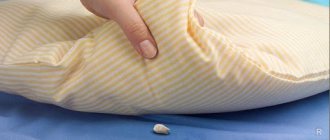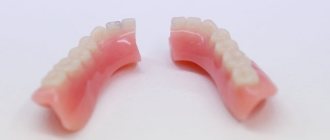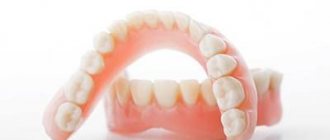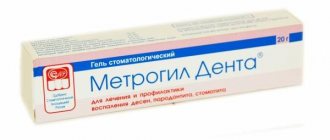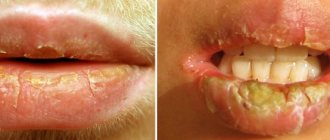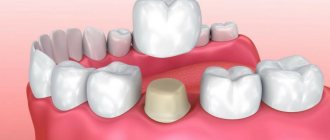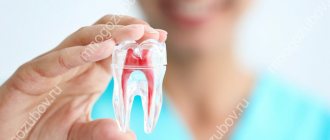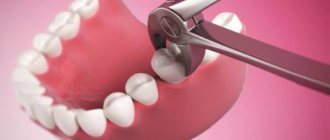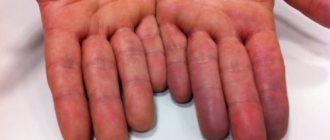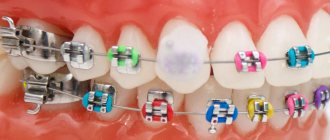3643
The job of braces is to create pressure on the problem units to force them to move and take the correct position in the dentition.
To provide optimal impact force, the system must be sufficiently rigid. For this reason, patients often complain to orthodontists that the structure rubs the inside of the cheeks.
This situation is quite unpleasant, but it can be corrected.
Is this normal?
It is believed that in the first two weeks of wearing orthodontic structures, it is quite natural to feel discomfort, which can manifest itself in various variations. The inconveniences will go away on their own after the adaptation period is completed. The mucous membrane must adapt to the foreign object in the mouth and get used to its presence.
In addition, other symptoms of discomfort arise that are provoked by the treatment that has begun. At this moment, the dental units are displaced under the influence of the pressure of braces, and the person feels additional pain.
But if you notice that serious wounds have begun to appear or the discomfort does not go away after a week or two, then you should contact the specialist who installed the system for you. It is quite possible that its position needs to be adjusted and then the braces will no longer cause discomfort.
If you skip this moment, you can wait until inflammation of the soft tissues joins the unpleasant painful sensations and infection of the oral cavity begins.
Eliminating the causes of mechanical injury
If rubbing of the mucous membranes is a mechanical injury due to deformations or breakdowns of structural elements, the following actions will help eliminate the cause:
- if there is an excessive length of the metal arc digging into the cheek, you should immediately contact your orthodontist out of turn, he will cut off the interfering edges with a special tool;
- you can carefully bend the bent ligature into place using a toothpick, being careful to avoid breaking the structure, or consult a doctor to replace it;
- a loose lock must be urgently reattached by a doctor, otherwise it will not only rub the mucous membranes, but also interfere with the work of the bite correction braces;
- Before gluing the bracket, you should not use intermaxillary elastics, if they are indicated for wearing;
- You can also try to carefully insert an arch that has jumped out of the grooves back with nail clippers or tweezers, and if that doesn’t work, then go to an unscheduled appointment with an orthodontist.
Helping the mucous membrane get used to braces
If all elements of the system are in order, then the reason for the braces rubbing the mucous membrane is either that the soft tissues have not yet had time to adapt to the structure in the mouth and they need help, or in the development of an allergic reaction to the material of the system. To facilitate the adjustment process in the initial stages of treatment and reduce the risk of soft tissue damage throughout its entire duration, orthodontic wax can be used.
This is a special plastic mass for creating a protective layer between the elements of braces and the tongue, the inner surface of the cheeks and lips. Its main components are natural beeswax and medical silicone; substances with antibacterial, wound-healing and anti-inflammatory effects, various natural flavors and flavoring additives can be used as additional ingredients. It has a white color and translucent structure; its use allows you to make the details of metal braces less noticeable.
Dental wax is packaged in plastic containers, which can be equipped with small mirrors, which facilitates the process of applying the mass in difficult conditions. Various manufacturers produce it in the form of individual rods, solid plates or dosed pieces arranged in separate cells. The most popular products are from Dentaid, 3M Unitek, DynaFlex, and L'industria Zingardi.
In many clinics, after installing braces, orthodontic wax is given to the patient with him; you can buy it in many pharmacies and in specialized online stores. The use of wax is not strictly necessary, but can significantly reduce discomfort during bite treatment. It also prevents injury to soft tissues in cases of breakage or deformation of the arch or brace locks until they are replaced or repaired.
Allergic manifestations from contact of system elements with the mucous membrane are treated with antihistamines (Suprastin, Tavegil, Zodak, Loratadine). However, if the reaction is severe and cannot be treated with medication, you should definitely consult the doctor who installed the braces and an allergist. In rare cases, it is necessary to replace the design with another hypoallergenic material (ceramics, plastic). Most often, allergic reactions in the oral cavity are caused by metal alloys.
Causes of the problem
Modern braces are made according to the following criteria:
- small size;
- from hypoallergenic materials;
- with rounded and smooth edges and lines.
All this is done for maximum patient comfort so that the products do not cause unnecessary discomfort. And yet you also need to get used to them. The appearance of inflammation or wounds begins more often in the following cases:
- The lock, that is, the bracket itself, has become detached from the tooth surface and the edge injures the mucous membrane.
- Increased sensitivity of tissues to metal alloys in the structure, which is reflected in the appearance of allergic inflammation.
- The arc is too long and not bent correctly. Sharp edges begin to scratch the cheeks from the inside and create wounds.
All of these problems are corrected in the office of the dentist or orthodontist when you seek help. The plate can be attached back with special glue, and the arc can be cut in the right place and bent correctly. In case of allergic reactions, replacement with other materials – ceramics, plastic, etc. – is quite adequate.
What causes chafing?
Braces are a foreign structure that creates special conditions inside the oral cavity for the correction of the dentofacial apparatus. In places where soft tissues come into contact with protruding elements, increased pressure occurs on the mucous membranes. Such areas most often become the inner surfaces of the lips, cheeks and tongue.
Increased salivation, which accompanies the first stages of adaptation to braces, leads to the fact that irritation, inflammation or wounds quickly appear at the site of friction. Sometimes there may be slight bleeding.
It takes about a week for habituation and natural thickening of the integumentary tissue in the contact zone to occur. Then, in these places, the surface of the mucous membrane grows and prevents the appearance of new rubbing and irritation.
Chafing is most often associated with three things:
- chafing locks;
- the wire rubs in the area of the missing tooth;
- rubs the end of the arc.
Locks
The maximum protruding parts of the system are on the locks. They create pronounced problems on the inside of the lips. The simplest way is to provide a mechanical barrier that will increase the contact area and reduce pressure in that area. To achieve this effect, protective orthodontic wax is used.
If a ligature system is installed, you should pay attention to whether the bent ends of the metal ligatures have caused chafing. Buckling can occur after intensive cleaning with a brush. If the reason is really bending, you need to take a toothpick and place the tail under the arc. The movement must be careful not to damage the system.
Another option is for the bracket to detach from the enamel due to weakening of the dental adhesive. Then the staple hangs on the arch and strongly rubs the lip. In this case, you need to urgently go to the orthodontist, who can fix it in the desired position.
Wire in place of missing tooth
In areas where one tooth is missing, the contact of the tongue and cheek with the arch is much stronger than expected. This may be irritating at first. The solution to this picture is only possible by increasing the contact area. In such cases, doctors recommend putting a special tube on top. You cannot do this on your own; you need to contact your doctor, and he will solve this issue in a matter of minutes. Such assistance does not require material costs. In two to three weeks, adaptation should occur and the tube can be removed.
Arc ends
The wire after installation may be longer than required. If the orthodontist does not shorten or curl the ends, they can cause chafing and scraping of the soft tissue. A similar problem should be solved by the specialist who installed the structure. After shortening, the discomfort immediately goes away or decreases significantly.
What to do if your braces rub?
The measures that can be taken in this case come down to the following options:
- eliminate the cause of mechanical injury;
- help the mucous membrane get used to the structure;
- heal existing inflammation or ulcers.
To anesthetize the surface and relieve the main unpleasant symptoms, doctors recommend using such affordable drugs as Colgate Orabase or Orajel. They can be bought at the pharmacy, and to understand how to use, just read the instructions.
To facilitate the adjustment process, dentists give the patient orthodontic wax along with the installation of the braces system. With its help, you can quickly reduce injury to the mucous membrane in the right place. If your doctor did not give it to you, then such a product can be purchased at a specialized pharmacy or you can use regular paraffin or beeswax instead.
To reduce inflammation and soothe the mucous membranes, you can use rinses. To do this, make a saline solution or prepare herbal decoctions. Such products quickly and safely act on soft tissues and help them heal in a short time.
Modern drugs
To reduce discomfort when braces rub, you can use an antisthetic. It can be purchased at the pharmacy in the form of a gel or rinse. This remedy will relieve pain for several hours.
It is also convenient that you can buy an antisthetic in almost any pharmacy, and it is issued without a doctor’s prescription due to the absence of significant contraindications.
The most common products are Colgate Orabase and Orajel.
How to use these tools is described in detail in the attached instructions. It is better to study allergic contraindications before using it.
We use wax for braces
This is the most competent and suitable option to prevent braces from chafing. It is recommended to use it from the first days of wearing structures. The instructions indicate simple steps:
- Determine where you need to protect the mucous surface from protruding elements of the product. To do this, use a mirror, use bright lighting and examine the condition of the oral cavity. You can ask your loved ones for help.
- Dry the part of the structure and tooth surface in the place where you are going to attach the wax. This can be done using cotton swabs.
- Tear off a small piece of the product and warm it between your fingers so that you can easily roll it into a ball.
- Attach it with a pressing motion to the protruding part of the braces, which injures the surrounding tissue. But do not press too hard so that the wax remains above the metal element.
This can be done with all parts of the structure that cause inconvenience. If you use such wax from the very first sensation of discomfort, you can avoid serious injuries and help the mucous membrane quickly get used to the foreign object.
It is important to remove wax from the structure before each meal and clean it thoroughly. This can be done by hand or using additional tools, such as a toothbrush or a special brush. But if you accidentally swallow orthodontic wax, do not worry, as it is completely harmless to the human body.
Video: pros and cons of braces.
How to protect the mucous membrane from rubbing with braces
What to do if your cheeks, tongue, lips and gums are covered with small ulcers after braces? The most common way to solve the problem, recommended by experts, is orthodontic wax.
The substance is applied to the surface of the bracket system elements, which are in direct contact with the mucous membranes of the mouth. This avoids direct contact and reduces painful friction. The wax is non-toxic and harmless in case the patient accidentally ingests it. When one layer is absorbed, the composition can be reapplied.
If wax does not save you from severe discomfort for more than 1-2 weeks, it most likely does not cope with its protective function. In such a situation, an immediate visit to the orthodontist is required.
Other ways to solve an unpleasant symptom
What else can be done at home to speed up the addiction process and alleviate discomfort? In the first days, doctors recommend adhering to the following rules:
- Avoid foods and drinks with high acid content, as they can further irritate the mucous membranes.
- Give preference to soft food; over time, you can switch to medium hardness. Solid foods can damage the structure, so it is better to avoid them for the entire period of bite correction.
- Rinsing with saline solutions will not only help reduce discomfort and eliminate emerging inflammation, but also act as an additional means of disinfecting the oral cavity.
- It is advisable for this period to choose a paste with potassium nitrate, which reduces gum sensitivity.
- To treat teeth and structures, use a soft or medium-hard brush.
Listen carefully to the doctor’s recommendations, who will tell you how to care for your teeth and the product. At the first sign of a structural breakdown, you should definitely visit a specialist rather than try to fix it yourself.
Some patients, especially teenagers, decide that chewing gum can help relieve their suffering. As a result, not only does the condition of teeth deteriorate due to actively spreading bacteria, but also the product itself breaks down. After all, such a substance is almost impossible to clean and remove from the structure, and due to its ductility, the elastic can pull the arc or lock in the other direction.
Therefore, doctors especially insist not to use such products during the correction process. This also applies to prunes, toffee candies, etc. Their use will complicate the treatment process and cause a lot of inconvenience in eliminating residues from the system.
Why do braces damage the mucous membrane?
Damage to the mucous membranes in the mouth in patients with braces more often occurs for the following reasons:
- The arch on which the braces are attached is longer than the required size . If the orthodontist does not cut off or bend the excess, the archwire will dig into the cheek or gum. The defect cannot be eliminated without the intervention of a specialist.
- Increased sensitivity to braces material . A reaction may occur to metal. The orthodontist will suggest a replacement system. There are modern materials that do not provoke allergies, and are also less noticeable on the teeth. They are more expensive, but a beautiful and healthy smile is worth the investment.
- The bracket has become detached from the tooth and damages the mucous membrane when moving . The surface must be cleaned and re-fixed with a special adhesive.
- The arc jumped out of its slots while brushing your teeth or eating . If the doctor has given instructions, you can try to correct the system, but it is better not to risk it. If the pressure differs from the set one, then the effect will be zero or the opposite.
- Sections of metal ligatures do not fit tightly onto the teeth . Besides the discomfort, wearing the system is pointless in this case.
All of the above reasons are related to the work of the orthodontist, so there is no way to eliminate them yourself at home.
A timely visit to the dental clinic will relieve the consequences of inflammation, discomfort and pain.
Wound with stomatitis
The disease often occurs in children under 3 years of age. It begins with numerous rashes on the mucous membranes of the mouth. Read carefully about stomatitis separately in the article:
Stomatitis in a child: how to treat at home? Drugs!
Red dots cover the inside of the lips, palate and cheeks, and are very itchy and scalding. As the rash matures, it becomes filled with purulent exudate, the epithelium looks irritated and inflamed. The inside of the mouth becomes covered with a whitish coating, which resembles curdled milk or a dense gray film. When you try to remove it, open erosions of a bright pink hue with copious discharge of ichor are exposed.
The causes of inflammation in stomatitis depend on the type of pathogen:
- candidiasis provokes the growth of fungi of the genus Candida;
- aphthous is a consequence of introduced microbes and bacteria such as staphylococci or streptococci;
- herpetic always develops against the background of the activity of human herperoviruses.
With stomatitis, a wound on the inside of the cheek in children interferes with chewing and talking, and it hurts greatly when touching the teeth. The inflammatory process is complicated by a sharp increase in temperature and chills, reminiscent of ARVI. Treatment depends on the cause and is carried out under the supervision of a dentist:
- If the disease is caused by yeast fungi, the best way to get rid of them is antimycotic agents in the form of solutions and ointments. Soak a gauze swab with Candide or Chlorhexidine liquid and remove plaque with it, trying to treat all areas around the wound. Apply Clotrimazole or Nystatin to the reddened areas and wash with water and soda.
- For herpes stomatitis, it is definitely recommended to take antiviral drugs: Remantadine, Derinat, Acyclovir, Cholisal. The wound is lubricated with light Acyclovir cream several times a day.
How to use orthodontic wax?
To use orthodontic wax correctly, you first need to mark the places where the braces rub. To do this, take a mirror and examine the entire oral cavity in good lighting. After identifying the places where the braces rub the lip or gum, the protruding parts of the structure are covered with wax. The procedure for gluing wax occurs according to the following principle:
- A piece the size of a match head is separated from a single piece of silicone by cutting or unscrewing. It is not advisable to pull the wax. This method will stretch the wax into a long ribbon that will be difficult to shape.
- Now you need to thoroughly dry the part of the structure that rubs the mucous membrane and will be covered with wax. For these purposes, you can use regular cotton swabs. The arch, bracket and the tooth itself are treated with wetting movements.
- The detached piece of wax is heated in the fingers until it can be rolled into a ball of the desired shape.
- The resulting ball is carefully attached to the problem area. During this procedure, you need to calculate the pressing force so that the wax sticks well, but does not violate the integrity of the entire structure and does not begin to climb through all the cracks between the teeth. It is also worth remembering that for orthodontic wax to be effective, it must protrude slightly above the braces.
- The procedure for applying silicone is repeated in the same way for all other areas of the structure that rub and cause discomfort.
Before eating, it is better to remove orthodontic wax from the surface of the braces. This can be done with a toothbrush or simply with your hands. If it is not removed, there is a high chance that it will be swallowed along with food. There's nothing wrong with that though. Wax is absolutely safe for human health.
If it is not possible to purchase orthodontic wax, you can use beeswax or paraffin. But using chewing gum (as some patients do) is strictly prohibited. It covers the main components of the bracket system, and its removal can lead to breakdown of the structure. In addition, chewing gum is an additional breeding ground for bacteria, and at the end of the treatment period, the teeth themselves will be straight, and the tooth enamel will be affected by various diseases.
When you should not wait, but run to the dentist
If irritation of the gum tissue, scratches and small abrasions do not go away for a long time, it is necessary to visit the dentist. Also, such a need arises if erosions or ulcers form on the mucous membrane, which cause bleeding and pain.
If unpleasant symptoms occur, the braces strongly scratch or rub in the oral cavity and these sensations do not go away, it is necessary to find out the reasons, since further actions depend on them. Often the reasons are:
- When the dentition is aligned, the metal arch lengthens, causing its edges to protrude, damaging the surface of the cheeks and gums.
- Too much care causes metal ligatures (tail ends) to move away from the surface of the dental crown, leaving marks on the mucosa.
- Departure from the surface enamel of the hinge joint causes trauma to the lips during chewing or speaking.
- When a tooth is missing, the section of the arch without a silicone tube is in close contact with the cheek or gum, digging into the soft tissue.
- If a metal arc comes out of the grooves of the locks.
DETAILS: Irrigator for braces - which is the best device for cleaning teeth
If for some reason the patient ignores these symptoms, then his chance of developing the following negative manifestations increases:
- The adaptation period increases significantly. In this case, excessive sensitivity is eliminated through the use of orthodontic wax.
- Parts of the metal structure may cause an allergic reaction. Such manifestations necessitate additional therapy.
What to do at home: how to speed up the process of adaptation to braces
To ensure that the comfort of life does not decrease after installing braces during the adaptation period, you must adhere to certain rules and recommendations.
To do this, when eating, you must follow the following rules:
- During the first week, you need to switch to food with a soft consistency (soups, pureed cereals, potato and fruit purees).
- You should not heat foods too much, but rather give preference to cold foods.
- Excess acid in foods and hot seasoning will provoke pain.
- The complete taboo should extend to any solid food.
DETAILS: All teeth are filled with braces
If braces rub the inner surface of the lips, cheeks, gums, tongue, or there is severe pain, the following remedies, both healing and others, can be used:
- Painkillers. In this case, experts advise taking Paracetamol at intervals of 4 hours. You can also use Analgin, Baralgin, Spazmalgon or Ibuprofen.
- Orajel or Colgate Orabase can be used as local anesthetics.
- Mouth rinsing should be done after every meal, using a solution of table salt or hydrogen peroxide.
- The use of orthodontic wax will create a protective barrier that minimizes contact of the protruding parts of the structure with the surface of the cheeks, tongue and gums.
It should be borne in mind that the daily procedure for hygienic oral care should be carried out with a special toothbrush with a small head and soft bristles. You also need to choose a toothpaste for braces.
Each meal should be accompanied by cleansing the mouth with dental floss or mouthwash (preferably with an antibacterial effect).
In addition, throughout the entire period of wearing braces, you need to periodically visit the dental clinic and follow all recommendations and medical orders.
Conclusion
Remember that the discomfort caused by the treatment will eventually go away as the teeth adjust to the braces. The discomfort that patients experience is due to the fact that the teeth are moving towards their final and optimal position. After that they don't hurt. You may experience slight pain for a few days, but the end result will be worth it: you will have a beautiful, perfectly straight smile.
We invite you to familiarize yourself with how much dental braces cost: prices for teenagers and children
Parents should also reward their child for good oral hygiene, as it is especially important to keep teeth and gums clean while wearing braces.
Your dentist, Mikhail Vyatkin

